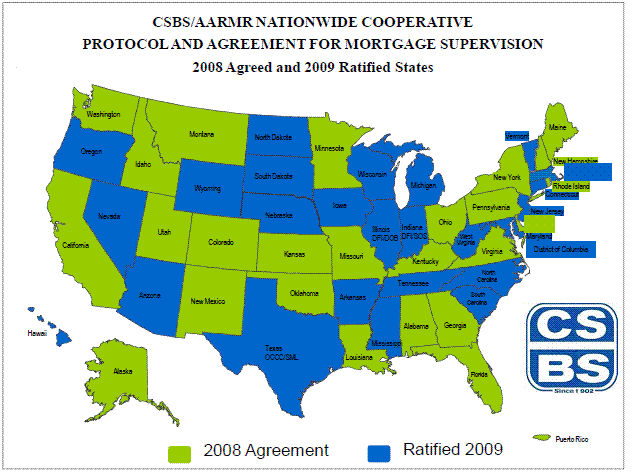The Conference of State Bank Supervisors (CSBS) and the American Association of Residential Mortgage Regulators (AARMR) today published the first report on multi-state examination efforts to improve supervision of the mortgage industry.
Forty-six states will be participating in the Nationwide Mortgage Licensing System (NMLS) by the first of the year according to a progress report released today by the Conference of State Bank Supervisors (CSBS) and the American Association of Residential Mortgage Regulators (AMRMR). All fifty states are expected to participate in the system by 2011.
NMLS which became operational on January 1, 2008, is an Internet-based system based on the registry used to regulate securities brokers and dealers. It provides a method for coordinating mortgage supervision and consumer protection among the states and is designed to prevent interstate mobility for mortgage originators or brokers with previous complaints or violations. The system is the result of work by mortgage regulators in a number of states to address problems in the old, fragmented licensing and supervision system.
All 50 states plus the District of Columbia and Puerto Rice have adopted the nationwide protocol for information and sharing of exams.

Today’s report claims that the system has licensed over 11,000 companies and 66,469 loan originators to date.
Steve Antonakes, Massachusetts Commissioner of Banks said of the multi-state initiative, “(It) is about uniformity in approach and modernization of processes. States have been hard at work for nearly two years delivering an examination format that is not only effective, but efficient for regulators and stakeholders.
“This report is the latest demonstration of the major steps states have taken to work together to improve supervision in the mortgage industry,” said Mark Pearce, AARMR President and Deputy Commissioner of Banks for North Carolina. “These efforts have significantly improved our ability to protect consumers from abusive practices in the mortgage industry.”
Other benchmarks achieved by the program in the past year include:
· Participation in the Federal/State Subprime Mortgage Lending Pilot to examine the origination of non-traditional mortgage loans.
· Development of regulatory guidance and the Model Examination Guidelines to improve consistency in mortgage regulation.
· Development of Reverse Mortgage Examination Guidelines to address emerging abuses.
· Development of examination standards to determine mortgage lenders’ consideration of a borrower’s ability to repay
· Development of uniform standards for accreditation of state agencies’ mortgage supervision programs and training of mortgage examiners.
Forty-nine states have legislatively updated their licensing regulations to meet or surpass the federal minimum requirements of the federal SAFE Act. Many of these states based their legislation on a model state statute developed by AARMR and CSBS and approved by the U.S. Department of Housing and Urban Development.
“The states have shown they can move quickly and in coordinated fashion to improve the consistency of regulation of the mortgage market,” said Pearce. “The federal SAFE Act serves as a model of how the federal and state governments can partner to protect consumers in the mortgage market.”
To read the entire report: CLICK HERE







